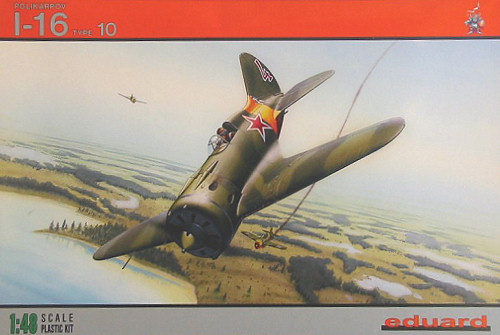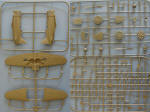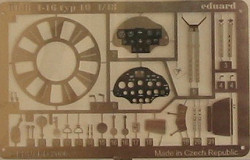
| KIT: | Eduard 1/48 I-16 type 10 |
| KIT #: | 8148 |
| PRICE: | $29.95 MSRP |
| DECALS: | Four options |
| REVIEWER: | Tom Cleaver |
| NOTES: | New Mold |

| HISTORY |
By 1930, Russian aviation and local design had made great strides. The Air Force’s scientific research institute (the NII V-VS) was producing outlines for the future of combat aircraft that few in the west at that time would have realized the Soviet Union was capable of designing, producing and operating. The development of future fighter aircraft was given a high priority. Two clear lines of thought emerged: with the powerplants and construction types available, superior speed could be gained from monoplane design, however the biplane demonstrated greater maneuverability. The solution prescribed by the NII was to operate mixed fighter formations of fast monoplanes and agile biplanes.
At the end of 1931, A. N. Tupolev was assigned the design of a new monoplane fighter, since his Bureau had extensive experience of monoplane design with very large bomber and transport aircraft. Pavel Sukhoi was in charge of design and the result was the I-14, an all metal, retractable undercarriage, cantilevered monoplane. Nikolai Polikarpov, having been released from prison after he and his design team had been arrested and imprisoned as a result of the crashes of a number of his design prototypes - due to the success of his I-5 and coming I-15 biplanes - asked permission to design a rival to the I-14. Design work on his new monoplane fighter, which had the bureau number TsKB-12, began in March 1933 and by December, the all-red prototype of what was to be known as the I-16, was flown by V.P. Chkalov. The I-14 had flown eight months earlier but there were several problems, including slow recovery from spins. Work on the I-14 was eventually discontinued after 22 aircraft had been completed.
While aluminum stressed skin construction was seen as the way of the future, Polikarpov's I-16 was of mixed construction. The fuselage was a wooden monocoque made of glued birch laths laid up over a basic four longeron frame with 11 stations. The completed wooden shell was covered with madapolan fabric for strength and sealing. The wing had a chrome-molybdenum steel tube truss-type center section, skinned with aluminum, while the outer wings had steel tube truss-type spars with steel sheet webs, and aluminum ribs, with the leading edge covered in aluminum and the wing aft of the main spar covered with fabric. The ailerons were aluminum covered with fabric. With no flaps fitted, the ailerons drooped 15 degrees for approach and landing. The tail was also a fabric covered aluminum structure. The landing gear was fully retractable through a complex series of cables and pulleys, operated manually from the cockpit. The cockpit had a fully enclosed canopy that slid forward for entry, assisted by bungee cords, with small side hatches. The canopy proved unpopular with pilots and was later replaced by a simple windscreen.
The two prototypes were powered by different engines, the first with a 480hp M-22, the Russian-produced Bristol Jupiter, with the second using a 715hp Wright R1820-F-3 Cyclone. It was intended that both powerplant options would eventually be produced, the lower powered machine being used as a transition trainer. State trials on both aircraft took place during February and April 1934, and various defects were identified and subsequently rectified, however it had become clear that the new aircraft was an outstanding machine and the decision to enter full-scale production was taken.
Initial production of the Type 5 utilized the M-22 engine, while the Type 10, introduced a year later, used the M-25, the license-built version of the Cyclone. While the Type 5 was armed with two 7.62mm ShKAS machine guns in the wings, the Type 10 had the additional armament of a pair of ShKAS weapons mounted in the forward fuselage, firing through the prop.
At the time the V-VS was putting the I-16 - with enclosed cockpit and fully retractable landing gear - into squadron service, the Luftwaffe was introducing the He-51 biplane, the RAF was still using the Fury and the Bulldog, and was just beginning to bring the Gloster Gauntlet, while the Japanese had only begun prototype construction of the Type 96 and the U.S. Army Air Corps was still taking delivery of the Boeing P-26. At the time of its introduction to service, the I-16 was the most advanced fighter in the world, and no one in the West knew it existed.
| THE KIT |
 There have been two 1/48 kits released of the I-16 that I know of, the most
accurate of which was a vacuform from MPM (back when MPM and Eduard were one
company in Cold War Czechoslovakia) that was barely available anywhere. Far
more available, and far less accurate, was the series of I-16s released by
Hobbycraft of Canada around 1990.
There have been two 1/48 kits released of the I-16 that I know of, the most
accurate of which was a vacuform from MPM (back when MPM and Eduard were one
company in Cold War Czechoslovakia) that was barely available anywhere. Far
more available, and far less accurate, was the series of I-16s released by
Hobbycraft of Canada around 1990.
Eduard’s I-16, which will eventually cover all the major versions of this
important aircraft, is definitely the best of the bunch and can be considered
“definitive.” While the old MPM vacuform had great surface detail, the surface
detail of this kit is even better, and the plastic molding quality definitely
puts Eduard in the “Tamigawa” class. All parts are cleanly molded and sharp in
definition. The kit provides a useable engine -
 considering you can’t really
see that much inside the cowl - with a fully-detailed cockpit. Photo-etch parts
include the cowling cover, the instrument panel, seat belts, and other small
details. My only complaint is that the side flaps are molded closed, limiting
the view of this well-detailed cockpit when completed. Fortunately, cutting
away the side flaps and replacing them with Evergreen sheet is easily done.
considering you can’t really
see that much inside the cowl - with a fully-detailed cockpit. Photo-etch parts
include the cowling cover, the instrument panel, seat belts, and other small
details. My only complaint is that the side flaps are molded closed, limiting
the view of this well-detailed cockpit when completed. Fortunately, cutting
away the side flaps and replacing them with Evergreen sheet is easily done.
The decal sheet provides markings for four V-VS Type-10s, and fully-detailed profiles to get painting and markings right.
Having already test-fitted the major parts, I can say that the production design of this kit is on par with anything released in the past 12 years by Tamiya, with everything fitting easily and correctly. Eduard is now a world-class competitor.
| CONCLUSIONS |
A beautiful kit of an historically-important airplane, that provides everything a modeler needs to make an excellent model, right in the box. The aftermarket people can go on to other kits that need their help - the only thing this will want is more decal options. Highly recommended to everyone from novice to master expert. Those with limited time for their modeling will not have to spend forever finishing this one.
Thanks to Eduard for the review sample.
May 2006
If you would like your product reviewed fairly and quickly by a site that has over 300,000 visitors a month, please contact me or see other details in the Note to Contributors.